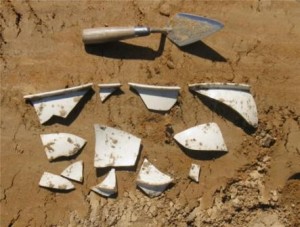

Facebook Twitter Flickr YouTube RSS Feed
Written on: October 4th, 2012 in Archaeology Updates, US301
The main event this week at the Bird-Houston site was well digging day, we used a backhoe to help us dig deeper into our wells than we had been able to dig by hand. We have three wells on the site, and we used a different approach for each. Of the two wells on the older half of the site, one was nearly sterile. We dug it to the bottom with a backhoe, and it was sterile all the way down. It was about 9 feet deep. The other well in this part of the site was our best feature, full of artifacts dating to around 1820. We had dug this by hand to a depth of about 4 feet. We used the backhoe to widen the hole so hand excavation could continue safely. The well continued to produce numerous artifacts, including these sherds of a creamware chamber pot.

When we tested the well in the newer part of the site, dating to around 1830 to 1920, we hit a solid layer of barbed wire about 4 feet down that we couldn’t dig through with a shovel. So the first thing we did with the backhoe was to dig down to that level and remove the barbed wire. The hole was widened at that depth to allow access, and the well was cleaned off and photographed. We had intended to hand excavate a sample of the well fill below that depth. However, the soil exposed at that depth was blue-gray clay, extremely dense and apparently sterile. So the backhoe was used to dig deeper. The idea was to dig only the east half of the well mechanically, exposing the profile; however, the exposed profile immediately began to collapse. The collapse exposed the remains of the well’s brick lining. The top of the brick section in the picture is about 6 feet below the stripped surface. The fill below this depth consisted mainly of brick from the lining, collapsed into the hole, with numerous nails but few other artifacts. The well seems to have had a fairly complex structure. As the bricks shown in the photo collapsed into the well, it was revealed that there was a layer of boards behind them, as if the well shaft had been lined with wood and then the brick ring built inside it. At the very bottom of the well was a massive wooden ring; the brick must have been sitting on this ring. The ring was about 9.5 feet below the stripped surface. It was an exciting day: three wells, each different from the other, and a lesson in the different techniques used in Delaware to dig and shore up wells.